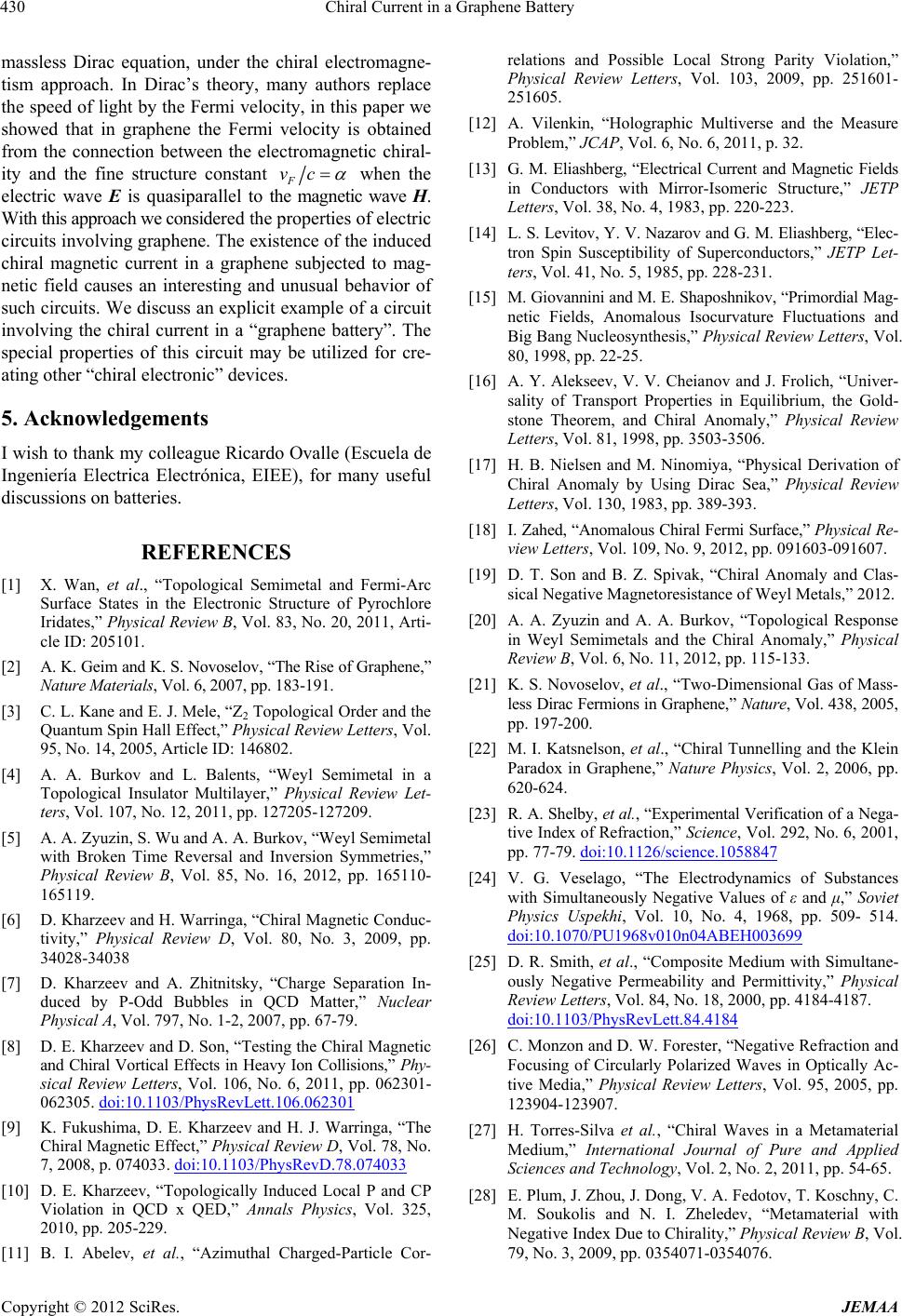
Chiral Current in a Graphene Battery
430
massless Dirac equation, under the chiral electromagne-
tism approach. In Dirac’s theory, many authors replace
the speed of light by the Fermi velocity, in this paper we
showed that in graphene the Fermi velocity is obtained
from the connection between the electromagnetic chiral-
ity and the fine structure constant F
vc
when the
electric wave E is quasiparallel to the magnetic wave H.
With this approach we considered the properties of electric
circuits involving graphene. The existence of the induced
chiral magnetic current in a graphene subjected to mag-
netic field causes an interesting and unusual behavior of
such circuits. We discuss an explicit example of a circuit
involving the chiral current in a “graphene battery”. The
special properties of this circuit may be utilized for cre-
ating other “chiral electronic” devices.
5. Acknowledgements
I wish to thank my colleague Ricardo Ovalle (Escuela de
Ingeniería Electrica Electrónica, EIEE), for many useful
discussions on batteries.
REFERENCES
[1] X. Wan, et al., “Topological Semimetal and Fermi-Arc
Surface States in the Electronic Structure of Pyrochlore
Iridates,” Physical Review B, Vol. 83, No. 20, 2011, Arti-
cle ID: 205101.
[2] A. K. Geim and K. S. Novoselov, “The Rise of Graphene,”
Nature Materials, Vol. 6, 2007, pp. 183-191.
[3] C. L. Kane and E. J. Mele, “Z2 Topological Order and the
Quantum Spin Hall Effect,” Physical Review Letters, Vol.
95, No. 14, 2005, Article ID: 146802.
[4] A. A. Burkov and L. Balents, “Weyl Semimetal in a
Topological Insulator Multilayer,” Physical Review Let-
ters, Vol. 107, No. 12, 2011, pp. 127205-127209.
[5] A. A. Zyuzin, S. Wu and A. A. Burkov, “Weyl Semimetal
with Broken Time Reversal and Inversion Symmetries,”
Physical Review B, Vol. 85, No. 16, 2012, pp. 165110-
165119.
[6] D. Kharzeev and H. Warringa, “Chiral Magnetic Conduc-
tivity,” Physical Review D, Vol. 80, No. 3, 2009, pp.
34028-34038
[7] D. Kharzeev and A. Zhitnitsky, “Charge Separation In-
duced by P-Odd Bubbles in QCD Matter,” Nuclear
Physical A, Vol. 797, No. 1-2, 2007, pp. 67-79.
[8] D. E. Kharzeev and D. Son, “Testing the Chiral Magnetic
and Chiral Vortical Effects in Heavy Ion Collisions,” Phy-
sical Review Letters, Vol. 106, No. 6, 2011, pp. 062301-
062305. doi:10.1103/PhysRevLett.106.062301
[9] K. Fukushima, D. E. Kharzeev and H. J. Warringa, “The
Chiral Magnetic Effect,” Physical Review D, Vol. 78, No.
7, 2008, p. 074033. doi:10.1103/PhysRevD.78.074033
[10] D. E. Kharzeev, “Topologically Induced Local P and CP
Violation in QCD x QED,” Annals Physics, Vol. 325,
2010, pp. 205-229.
[11] B. I. Abelev, et al., “Azimuthal Charged-Particle Cor-
relations and Possible Local Strong Parity Violation,”
Physical Review Letters, Vol. 103, 2009, pp. 251601-
251605.
[12] A. Vilenkin, “Holographic Multiverse and the Measure
Problem,” JCAP, Vol. 6, No. 6, 2011, p. 32.
[13] G. M. Eliashberg, “Electrical Current and Magnetic Fields
in Conductors with Mirror-Isomeric Structure,” JETP
Letters, Vol. 38, No. 4, 1983, pp. 220-223.
[14] L. S. Levitov, Y. V. Nazarov and G. M. Eliashberg, “Elec-
tron Spin Susceptibility of Superconductors,” JETP Let-
ters, Vol. 41, No. 5, 1985, pp. 228-231.
[15] M. Giovannini and M. E. Shaposhnikov, “Primordial Mag-
netic Fields, Anomalous Isocurvature Fluctuations and
Big Bang Nucleosynthesis,” Physical Review Letters, Vol.
80, 1998, pp. 22-25.
[16] A. Y. Alekseev, V. V. Cheianov and J. Frolich, “Univer-
sality of Transport Properties in Equilibrium, the Gold-
stone Theorem, and Chiral Anomaly,” Physical Review
Letters, Vol. 81, 1998, pp. 3503-3506.
[17] H. B. Nielsen and M. Ninomiya, “Physical Derivation of
Chiral Anomaly by Using Dirac Sea,” Physical Review
Letters, Vol. 130, 1983, pp. 389-393.
[18] I. Zahed, “Anomalous Chiral Fermi Surface,” Physical Re-
view Letters, Vol. 109, No. 9, 2012, pp. 091603-091607.
[19] D. T. Son and B. Z. Spivak, “Chiral Anomaly and Clas-
sical Negative Magnetoresistance of Weyl Metals,” 2012.
[20] A. A. Zyuzin and A. A. Burkov, “Topological Response
in Weyl Semimetals and the Chiral Anomaly,” Physical
Review B, Vol. 6, No. 11, 2012, pp. 115-133.
[21] K. S. Novoselov, et al., “Two-Dimensional Gas of Mass-
less Dirac Fermions in Graphene,” Nature, Vol. 438, 2005,
pp. 197-200.
[22] M. I. Katsnelson, et al., “Chiral Tunnelling and the Klein
Paradox in Graphene,” Nature Physics, Vol. 2, 2006, pp.
620-624.
[23] R. A. Shelby, et al., “Experimental Verification of a Nega-
tive Index of Refraction,” Science, Vol. 292, No. 6, 2001,
pp. 77-79. doi:10.1126/science.1058847
[24] V. G. Veselago, “The Electrodynamics of Substances
with Simultaneously Negative Values of ε and μ,” Soviet
Physics Uspekhi, Vol. 10, No. 4, 1968, pp. 509- 514.
doi:10.1070/PU1968v010n04ABEH003699
[25] D. R. Smith, et al., “Composite Medium with Simultane-
ously Negative Permeability and Permittivity,” Physical
Review Letters, Vol. 84, No. 18, 2000, pp. 4184-4187.
doi:10.1103/PhysRevLett.84.4184
[26] C. Monzon and D. W. Forester, “Negative Refraction and
Focusing of Circularly Polarized Waves in Optically Ac-
tive Media,” Physical Review Letters, Vol. 95, 2005, pp.
123904-123907.
[27] H. Torres-Silva et al., “Chiral Waves in a Metamaterial
Medium,” International Journal of Pure and Applied
Sciences and Technology, Vol. 2, No. 2, 2011, pp. 54-65.
[28] E. Plum, J. Zhou, J. Dong, V. A. Fedotov, T. Koschny, C.
M. Soukolis and N. I. Zheledev, “Metamaterial with
Negative Index Due to Chirality,” Physical Review B, Vol.
79, No. 3, 2009, pp. 0354071-0354076.
Copyright © 2012 SciRes. JEMAA